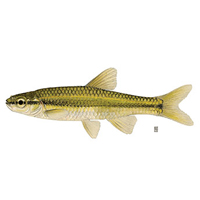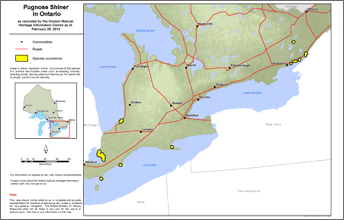Pugnose shiner
Scientific name: Notropis anogenus

Cover photo credit: Ellen Edmonson (NYSDEC)
Status
Threatened
“Threatened” means the species lives in the wild in Ontario, is not endangered, but is likely to become endangered if steps are not taken to address factors threatening it.
Date added to the Species at Risk in Ontario List
The Pugnose Shiner was already assessed as endangered when the Endangered Species Act took effect in 2008. It was reassessed and on June 27, 2014 it was listed as threatened.
Read the assessment report (PDF)
What it looks like
The Pugnose Shiner is a small, slender minnow that can reach five to six centimetres in length.
It is a silvery colour with pale yellow to olive-coloured markings on its back and a dark (sometimes inconspicuous) stripe along the side of the body that extends from the tail to the snout.
The fins are pale and without pigmentation. This species has large eyes and a very small, upturned mouth.
It is very similar in appearance to several other species of shiners that are found in Ontario.
Where it lives
The Pugnose Shiner is found in lakes and calm areas of rivers and creeks having clear water and bottoms of sand, mud or organic matter.
It prefers water bodies with plenty of aquatic vegetation, particularly stonewort (Chara sp.).
Aquatic plants provide hiding places, food, and breeding habitat.
The Pugnose Shiner eats aquatic plants, green algae, plankton and some aquatic insects.
Where it’s been found in Ontario
In North America, the Pugnose Shiner is found in several tributaries of the upper Mississippi River, in the upper Red River drainage and in the Great Lakes drainage.
In Canada, the Pugnose Shiner is found only at a few sites in southern Ontario, including the Teeswater River, the old Ausable Channel, the Trent River and a few coastal wetlands in Lake St. Clair (and some tributaries), Lake Erie, lower Lake Huron, Lake Ontario and the St. Lawrence River.
The population sizes at these sites are unknown.
View a Larger version of this map (PDF)
What threatens it
The main threat to the Pugnose Shiner is habitat degradation, including the alteration and destruction of wetlands and increased erosion from shoreline development.
Waterbodies where this fish currently lives are becoming less suitable due to soil washing into the water from nearby urban and agricultural development.
Invasive species, such as Eurasian Watermilfoil, are also a concern in some areas.
Action we are taking
Threatened species and their general habitat are automatically protected
Recovery strategy
A recovery strategy advises the ministry on ways to ensure healthy numbers of the species return to Ontario.
Read the executive summary (November 22, 2013)
Read the recovery strategy (November 22, 2013)
Government response statement
A government response statement outlines the actions the government intends to take or support to help recover the species.
Read the government response statement (December 15, 2014)
Review of progress
A review of progress made toward protecting and recovering a species is required no later than the time specified in the species’ government response statement, or not later than five years after the government response statement is published if no time is specified.
Read the report on progress towards the protection and recovery of 16 species at risk, including Pugnose Shiner (Notropis anogenus) (2019).
Habitat protection
General Habitat Protection - June 30, 2013
What you can do
Report a sighting
Report a sighting of an endangered animal or plant to the Natural Heritage Information Centre. Photographs with specific locations or mapping coordinates are always helpful.
Volunteer
Volunteer with your local nature club or provincial park to participate in surveys or stewardship work focused on species at risk.
Be a good steward
- Private land owners have a very important role to play in species recovery; if you find Pugnose Shiner in a watercourse on or adjacent to your property, you may be eligible for stewardship programs that support the protection and recovery of species at risk and their habitats.
- Invasive species seriously threaten many of Ontario’s species at risk; to learn what you can do to help reduce the threat of invasive species, visit:
- Farmers and land owners can help improve fish habitat and keep Ontario’s water safe and clean by maintaining natural vegetation next to creeks and rivers, and keeping pollution and soil from washing into Ontario’s streams and rivers; for more information about programs and funding assistance for eligible land owners visit the Ontario Soil and Crop Improvement Association website.
Report illegal activity
Report any illegal activity related to plants and wildlife to
Quick facts
- The Pugnose Shiner is one of the rarest minnows in eastern North America.
- The Pugnose Shiner has a very small mouth. Its scientific name “anogenus” is a Greek word that means ‘without a chin’.
- This fish is very timid and will retreat to hiding places in underwater vegetation when frightened.
- The Pugnose Shiner and the Pugnose Minnow are often thought to be the same species, but in fact are two distinct species, both are considered species at risk, both provincially and federally.
